Optical Vortex Beams with a Symmetric OAM Spectrum beyond a Sector Aperture
Abstract
1. Introduction
2. Orbital Angular Momentum of Superposition of Vortices with Symmetric Spectrum
3. Topological Charge of Superposition of Vortices with Symmetric OAM Spectrum
4. Conservation of the OAM Carried by a Field with Symmetric OAM Spectrum after Passing through a Sector Aperture
5. Topological Charge of Superposition with Symmetric OAM Spectrum after Passing through a Sector Aperture
6. Simulation
6.1. Preservation of OAM after Diaphragm
6.2. Integer TC of the Beam after Passing through a Sector Aperture
7. Conclusions
Author Contributions
Funding
Institutional Review Board Statement
Informed Consent Statement
Data Availability Statement
Acknowledgments
Conflicts of Interest
References
- Kotlyar, V.V.; Kovalev, A.A.; Porfirev, A.P. Vortex Laser Beams; CRC Press: Boca Raton, FL, USA, 2018. [Google Scholar]
- Allen, L.; Beijersbergen, M.W.; Spreeuw, R.J.C.; Woerdman, J.P. Orbital angular momentum of light and the transformation of Laguerre–Gaussian laser modes. Phys. Rev. A 1992, 45, 8185–8189. [Google Scholar] [CrossRef] [PubMed]
- Gori, F.; Guattari, G.; Padovani, C. Bessel-Gauss beams. Opt. Commun. 1987, 64, 491–495. [Google Scholar] [CrossRef]
- Kotlyar, V.V.; Skidanov, R.V.; Khonina, S.N.; Soifer, V.A. Hypergeometric modes. Opt. Lett. 2007, 32, 742–744. [Google Scholar] [CrossRef]
- Karimi, E.; Zito, G.; Piccirillo, B.; Marrucci, L.; Santamato, E. Hypergeometric-Gaussian modes. Opt. Lett. 2007, 32, 3053–3055. [Google Scholar] [CrossRef] [PubMed]
- Kotlyar, V.V.; Kovalev, A.A. Family of hypergeometric laser beams. J. Opt. Soc. Am. A 2008, 25, 262–270. [Google Scholar] [CrossRef]
- Bandres, M.A.; Gutiérrez-Vega, J.C. Circular beams. Opt. Lett. 2008, 33, 177–179. [Google Scholar] [CrossRef]
- Kovalev, A.A.; Kotlyar, V.V. Orbital angular momentum of superpositions of optical vortices perturbed by a sector aperture. Photonics 2022, 9, 531. [Google Scholar] [CrossRef]
- Kotlyar, V.V.; Kovalev, A.A. Optical vortex beams with a symmetric and almost symmetric OAM spectrum. J. Opt. Soc. Am. A 2021, 38, 1276–1283. [Google Scholar] [CrossRef] [PubMed]
- Zhu, K.; Zhou, G.; Li, X.; Zheng, X.; Tang, H. Propagation of Bessel-Gaussian beams with optical vortices in turbulent atmosphere. Opt. Express 2008, 16, 21315. [Google Scholar] [CrossRef]
- Yuan, Y.; Lei, T.; Li, Z.; Li, Y.; Gao, S.; Xie, Z.; Yuan, X. Beam wander relieved orbital angular momentum communication in turbulent atmosphere using Bessel beams. Sci. Rep. 2017, 7, 42276. [Google Scholar] [CrossRef]
- Gruska, J. Propagation and self-healing properties of Bessel-Gaussian beam carrying orbital angular momentum in an underwater environment. Sci. Rep. 2019, 9, 2025. [Google Scholar]
- Li, J.; Yang, S.; Guo, L. Propagation characteristics of Gaussian beams in plasma sheath turbulence. IET Microw. Antennas Prop. 2017, 11, 280. [Google Scholar] [CrossRef]
- Chen, W.; Zhu, G.; Deng, Q.; Yang, L.; Li, J. Analysis of Gaussian beam broadening and scintillation index in anisotropic plasma turbulence. Waves Rand. Complex Media, 2022, in press. [CrossRef]
- Li, J.; Yang, S.; Guo, L.; Cheng, M. Anisotropic power spectrum of refractive-index fluctuation in hypersonic turbulence. Appl. Opt. 2016, 55, 9137. [Google Scholar] [CrossRef]
- Wang, J. Advances in communications using optical vortices. Photonics Res. 2016, 4, B14. [Google Scholar] [CrossRef]
- Wang, J.; Liu, J.; Li, S.; Zhao, Y.; Du, J.; Zhu, L. Orbital angular momentum and beyond in free-space optical communications. Nanophotonics 2022, 11, 645. [Google Scholar] [CrossRef]
- Willner, A.E.; Pang, K.; Song, H.; Zou, K.; Zhou, H. Orbital angular momentum of light for communications. Appl. Phys. Rev. 2021, 8, 041312. [Google Scholar] [CrossRef]
- Zhu, Z.; Janasik, M.; Fyffe, A.; Hay, D.; Zhou, Y.; Kantor, B.; Winder, T.; Boyd, R.W.; Leuchs, G.; Shi, Z. Compensation-free high-dimensional free-space optical communication using turbulence-resilient vector beams. Nat. Commun. 2021, 12, 1666. [Google Scholar] [CrossRef]
- Berry, M.V.; Jeffrey, M.R.; Mansuripur, M. Orbital and spin angular momentum in conical diffraction. J. Opt. A Pure Appl. Opt. 2005, 7, 685–690. [Google Scholar] [CrossRef]
- Berry, M.V. Optical vortices evolving from helicoidal integer and fractional phase steps. J. Opt. A Pure Appl. Opt. 2004, 6, 259–268. [Google Scholar] [CrossRef]
- Abramowitz, M.; Stegun, I.A. Handbook of Mathematical Functions: With Formulas, Graphs, and Mathematical Tables; National Bureau of Standards: Gaithersburg, MD, USA, 1965.
- Tamburini, F.; Mari, E.; Sponselli, A.; Thide, B.; Bianchini, A.; Romanato, F. Encoding many channels on the same frequency through radio vorticity: First experimental test. New J. Phys. 2012, 14, 033001. [Google Scholar] [CrossRef]
- Petrov, D.V. Vortex-edge dislocation interaction in a linear medium. Opt. Commun. 2001, 188, 307–312. [Google Scholar] [CrossRef]
- Petrov, D.V. Splitting of an edge dislocation by an optical vortex. Opt. Quantum Electron. 2002, 34, 759–773. [Google Scholar] [CrossRef]
- He, D.; Yan, H.; Lu, B. Interaction of the vortex and edge dislocation embedded in a cosh-Gaussian beam. Opt. Commun. 2009, 282, 4035–4044. [Google Scholar] [CrossRef]
- Franke-Arnold, S.; Barnet, S.M.; Yao, E.; Leach, J.; Courtial, J.; Padgett, M. Uncertainty principle for angular position and angular momentum. New J. Phys. 2004, 6, 103. [Google Scholar] [CrossRef]
- Volyar, A.V.; Akimova, Y.E. Transformations of structurally stable states of spiral beams subjected to sector perturbations. Comput. Opt. 2021, 45, 789–799. [Google Scholar] [CrossRef]
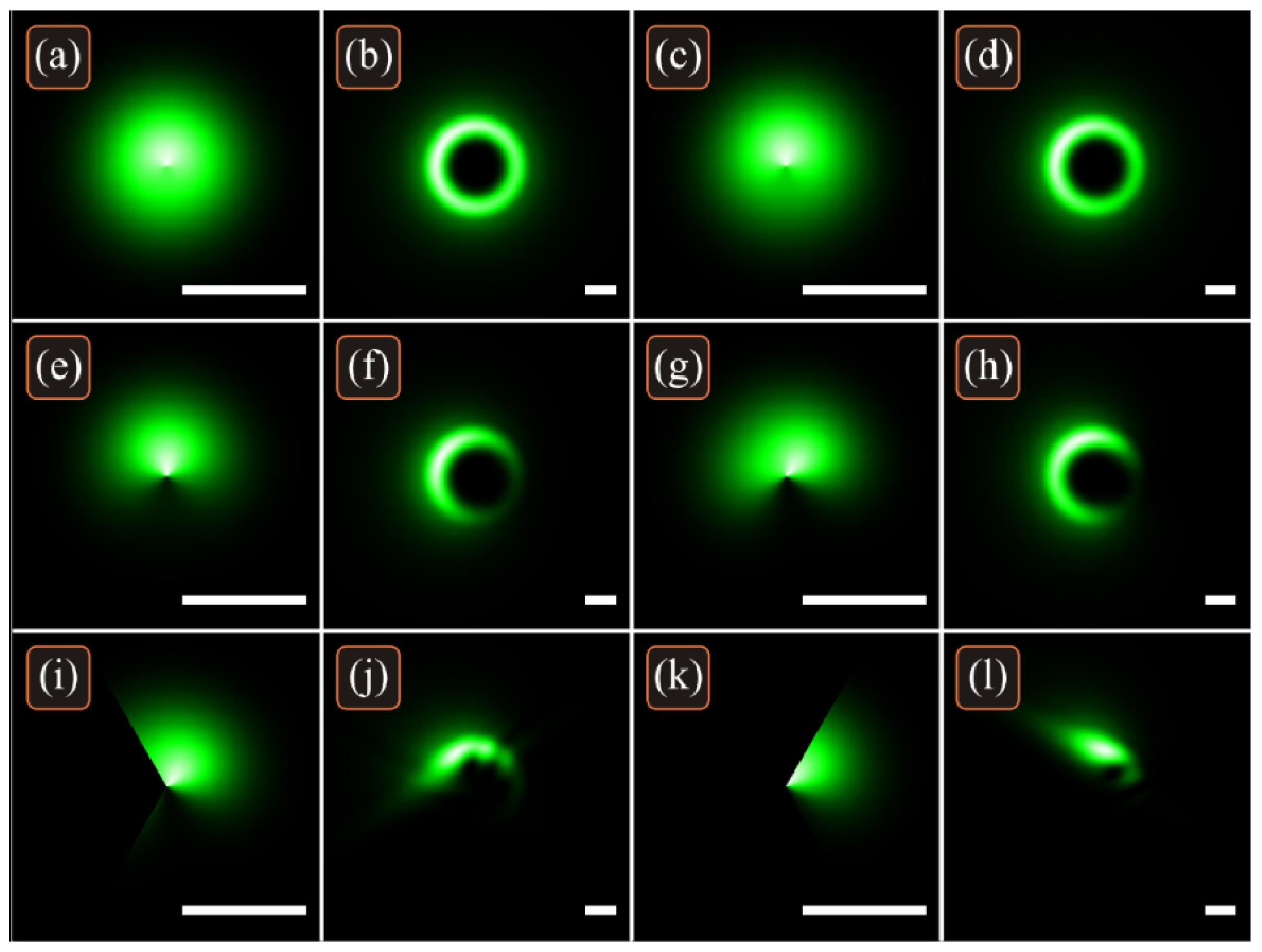


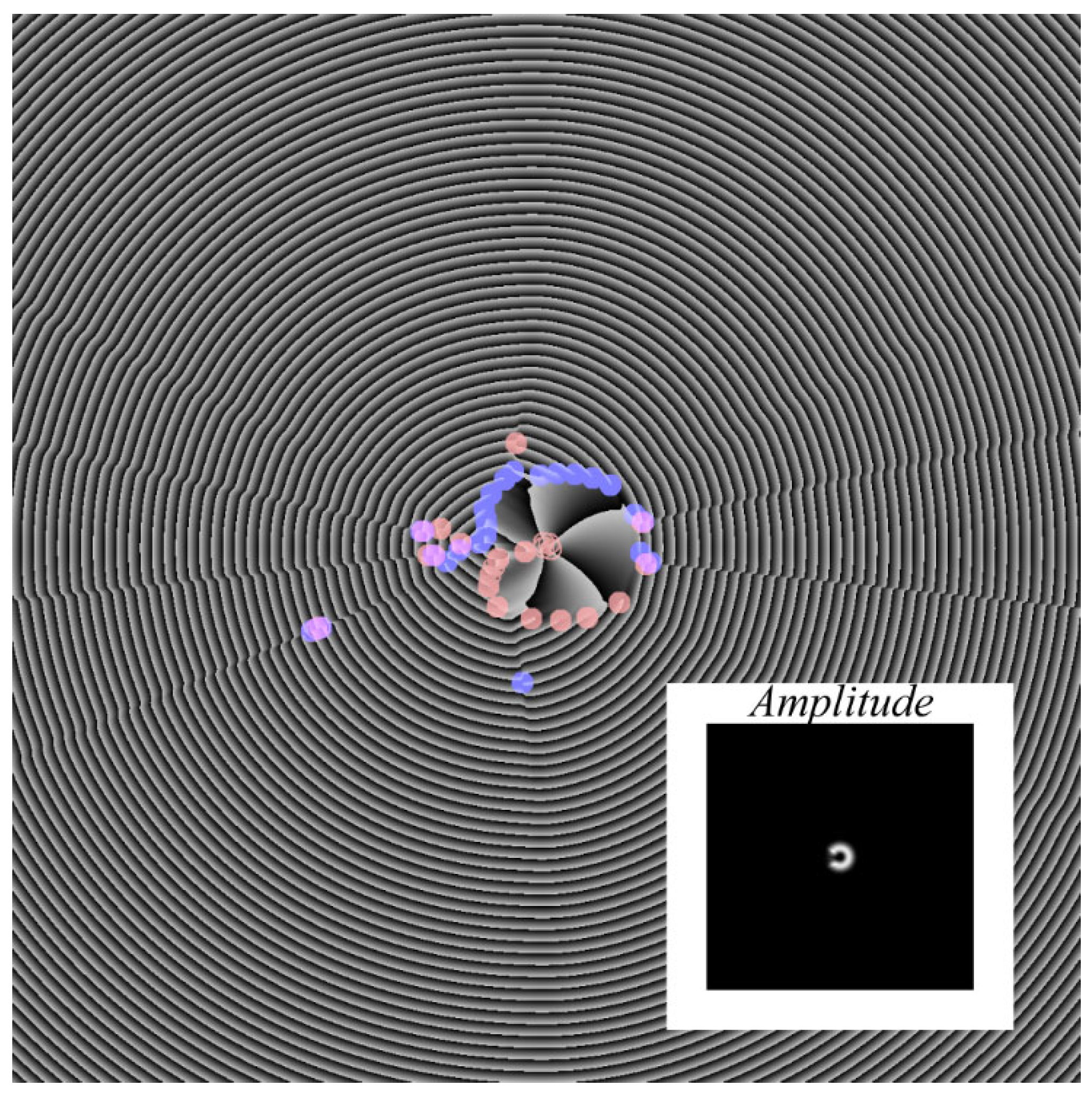

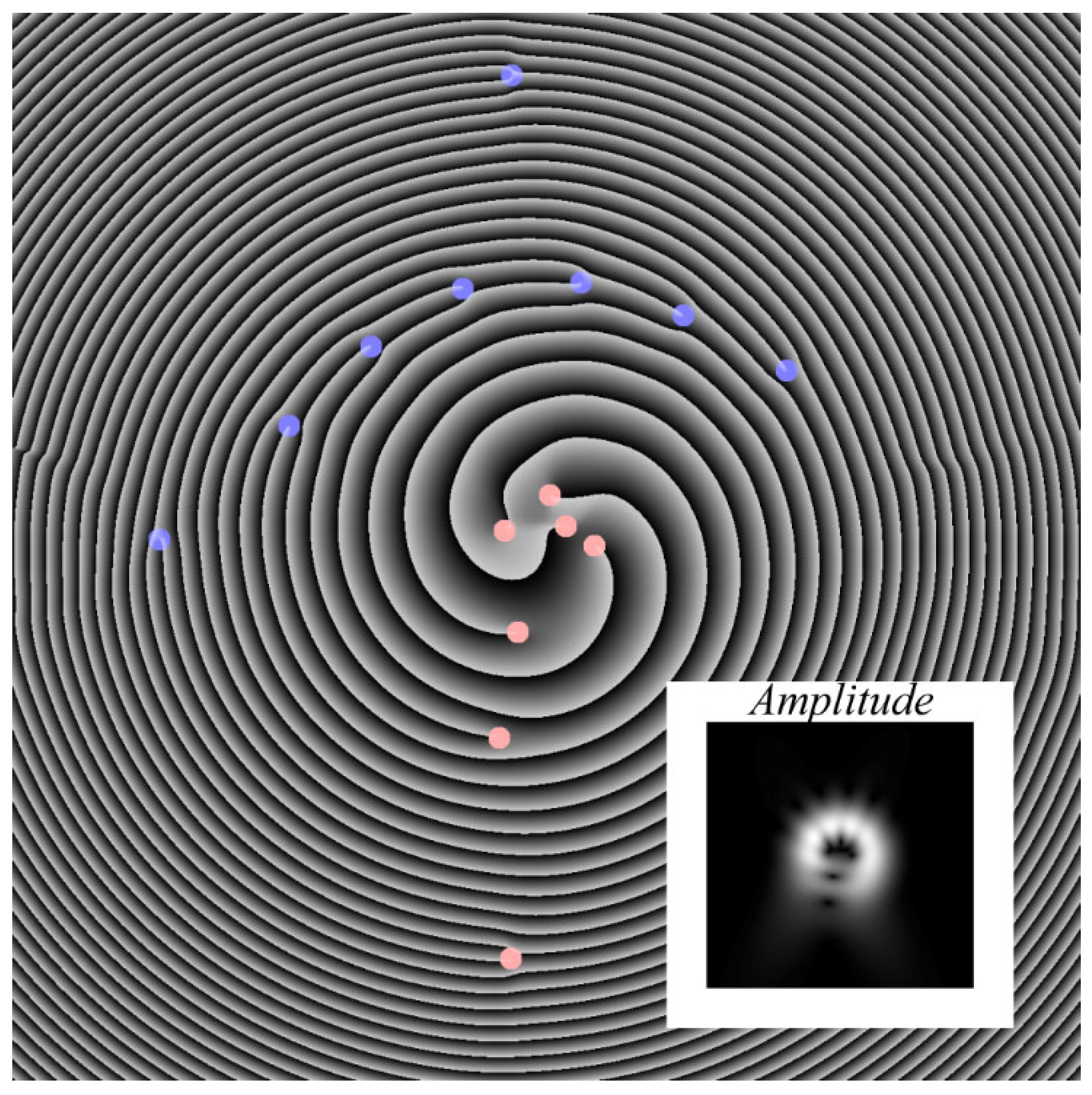
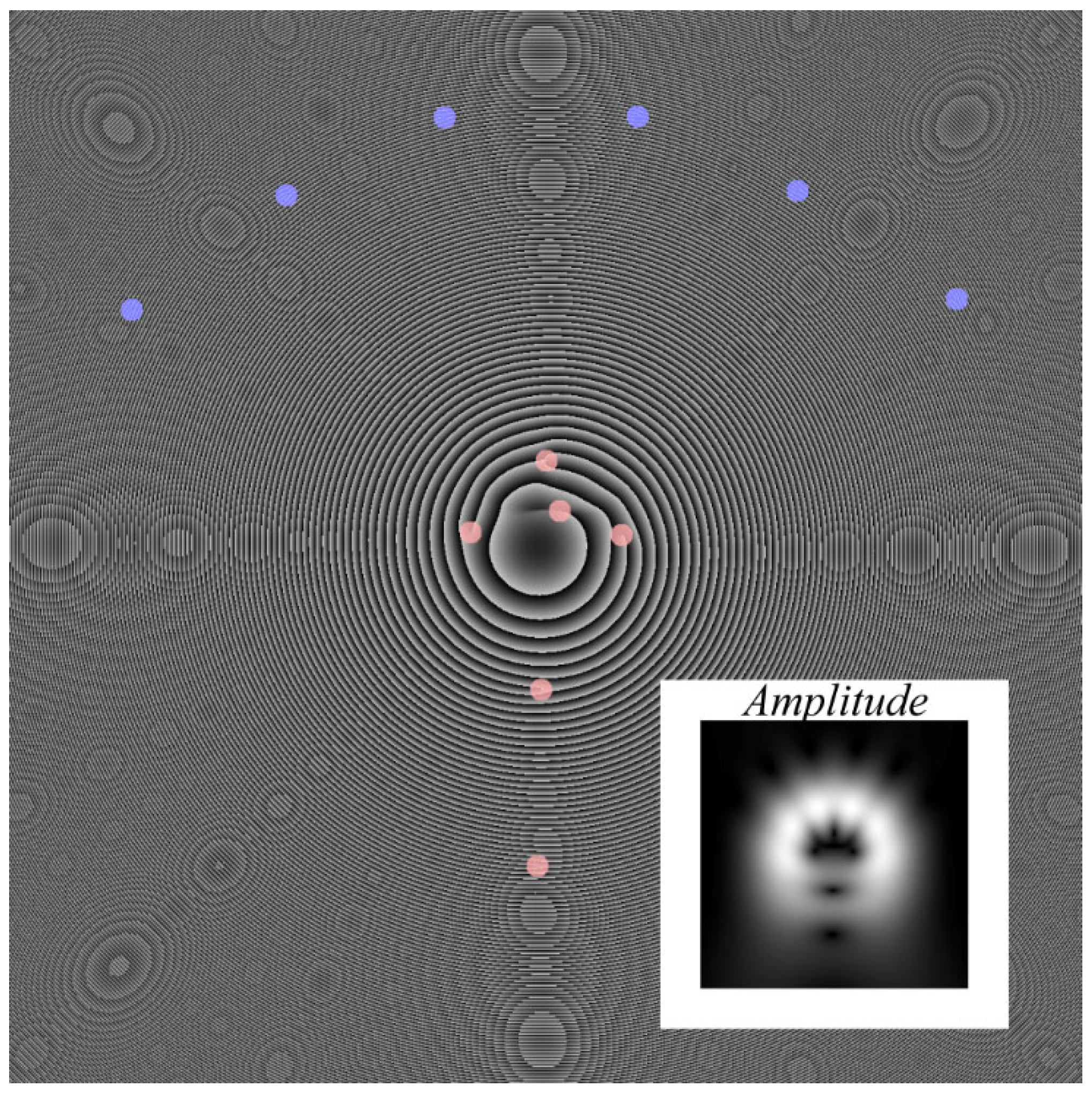
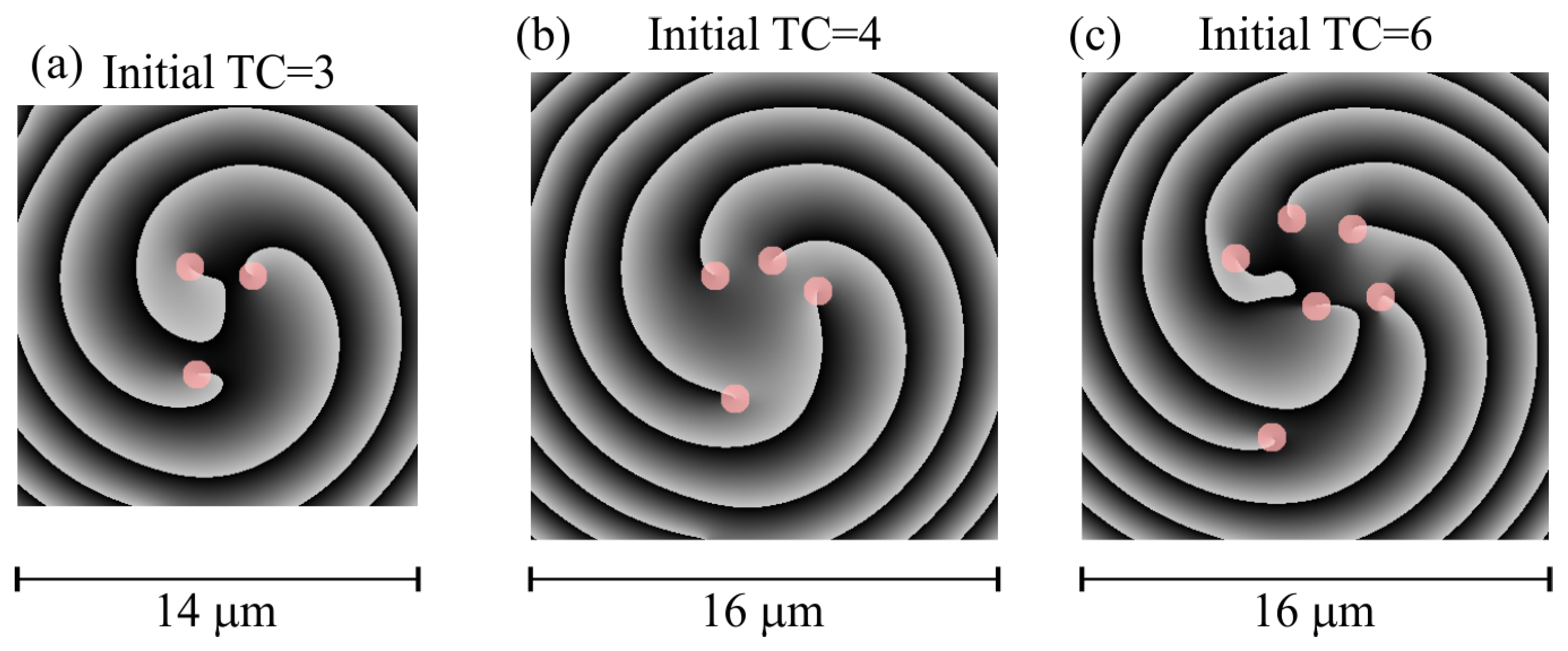
Publisher’s Note: MDPI stays neutral with regard to jurisdictional claims in published maps and institutional affiliations. |
© 2022 by the authors. Licensee MDPI, Basel, Switzerland. This article is an open access article distributed under the terms and conditions of the Creative Commons Attribution (CC BY) license (https://creativecommons.org/licenses/by/4.0/).
Share and Cite
Kotlyar, V.V.; Kovalev, A.A.; Nalimov, A.G. Optical Vortex Beams with a Symmetric OAM Spectrum beyond a Sector Aperture. Photonics 2022, 9, 734. https://doi.org/10.3390/photonics9100734
Kotlyar VV, Kovalev AA, Nalimov AG. Optical Vortex Beams with a Symmetric OAM Spectrum beyond a Sector Aperture. Photonics. 2022; 9(10):734. https://doi.org/10.3390/photonics9100734
Chicago/Turabian StyleKotlyar, Victor V., Alexey A. Kovalev, and Anton G. Nalimov. 2022. "Optical Vortex Beams with a Symmetric OAM Spectrum beyond a Sector Aperture" Photonics 9, no. 10: 734. https://doi.org/10.3390/photonics9100734
APA StyleKotlyar, V. V., Kovalev, A. A., & Nalimov, A. G. (2022). Optical Vortex Beams with a Symmetric OAM Spectrum beyond a Sector Aperture. Photonics, 9(10), 734. https://doi.org/10.3390/photonics9100734




